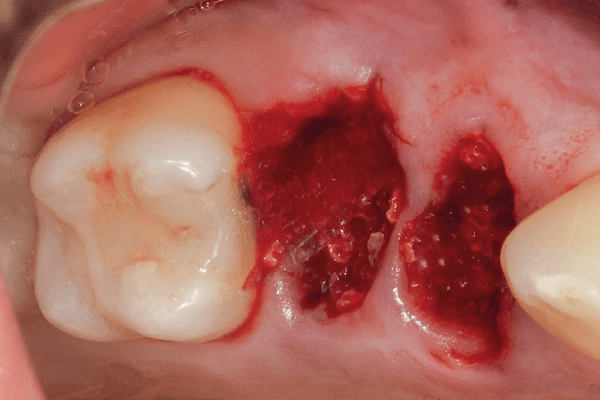Autores
1 – Felipe Severo Pohlmann
Mestrando em Odontologia – PUCRS; Especialista em Implantodontia – Avatis; Especialista em Ortodontia – Funorte. 0009-0008-1278-3213.
2 – Rafael Manfro
Mestre em Implantodontia – Unisa; Doutor em Implantodontia – SLMandic; Coordenador dos cursos de Cirurgia Avançada para Implantodontia – Abosc e Unisul. 0000-0002-7431-0170.
3 – Gislaine Fernandes Felipe Garcia
Mestra em Implantodontia – SLMandic; Professora dos cursos de Cirurgia Avançada para Implantodontia – Abosc e Unisul. 0000-0002-6081-5012.
4 – Maurício Rosa
Especialista em Implantodontia – Funorte; Professor dos cursos de Cirurgia Avançada para Implantodontia – Abosc e Unisul. 0000-0002-3895-5983.
5 – Bruno Eduardo Sant`Anna Falce de Macedo
Graduado em Odontologia – PUCPR; Mestrando em Clínica Odontológica, subárea Estomatologia – PUCPR. 0000-0003-1648-6036.
DOI: https://doi.org/10.71440/2675-5610.10.2.25.198-204.art
Resumo
A preservação de alvéolos pós-exodontia é fundamental em Implantodontia, para manter a integridade dos tecidos que receberão os implantes instalados a seguir. Este artigo explorou o uso de membranas de ácido polilático e poliglicólico em alvéolos com comprometimento da tábua óssea vestibular, destacando a importância de evitar o levantamento de retalho para preservar papilas e cristas ósseas, utilizando técnicas flapless. Neste trabalho, foram apresentados três casos clínicos em que foram utilizadas membranas para a regeneração de quatro alvéolos na região posterior da maxila. As técnicas de tunelização permitiram a colocação das membranas sem levantamento de retalho e, após a cicatrização, demonstraram uma recuperação adequada em volume e qualidade óssea. As membranas utilizadas facilitam a tunelização devido à sua consistência, permitindo uma preservação eficaz da arquitetura alveolar. As técnicas aplicadas possibilitaram a regeneração dos alvéolos de forma previsível, mesmo em condições adversas de comprometimento ósseo. Concluiu-se que a técnica de tunelização com membranas de ácido polilático e poliglicólico mostrou-se eficaz na regeneração de alvéolos com comprometimento severo da tábua óssea, permitindo a instalação de implantes sem a necessidade de técnicas adicionais para aumento ósseo.
Palavras-chave: Implantodontia; Preservação alveolar; Membranas biodegradáveis; Ácido polilático; Ácido poliglicólico.
Use of polylactic and polyglycolic acid membranes in the treatment of post-extraction sockets with compromised buccal bone plate – presentation of 3 clinical cases
Abstract
The preservation of alveoli post-extraction is essential in implantology to maintain the integrity of tissues that will subsequently have implants installed. This paper explores the use of polylactic and polyglycolic acid membranes in alveoli with compromised vestibular bone plates, highlighting the importance of avoiding flap elevation to preserve papillae and bone crests, using flapless techniques. This study presents three clinical cases where membranes were used for the regeneration of four alveoli in the posterior region of the maxilla. The tunneling techniques allowed the placement of the membranes without flap elevation, which, after healing, demonstrated adequate recovery in volume and bone quality. The membranes used facilitate tunneling due to their consistency, allowing effective preservation of alveolar architecture. The applied techniques enabled the predictable regeneration of the alveoli, even under adverse conditions of bone compromise. It is concluded that the tunneling technique with polylactic and polyglycolic acid membranes proved effective in the regeneration of alveoli with severe bone plate compromise, allowing the installation of implants without the need for additional bone augmentation techniques.
Keywords: Implantology; Alveolar preservation; Biodegradable membranes; Polylactic acid; Polyglycolic acid.
Referencias
- Fugazzotto PA. Implant placement at the time of maxillary molar extraction: technique and report of preliminary results of 83 sites. J Periodontol 2006;77(2):302-9.
- Jesch P, Jesch W, Bruckmoser E, Krebs M, Kladek T, Seemann R. An up to 17-year follow-up retrospective analysis of a minimally invasive, flapless approach: 18 945 implants in 7783 patients. Clin Implant Dent Relat Res 2018;20(3):393-402.
- Meijer HJA, Slagter KW, Vissink A, Raghoebar GM. Buccal bone thickness at dental implants in the maxillary anterior region with large bony defects at time of immediate implant placement: a 1-year cohort study. Clin Implant Dent Relat Res 2019;21(1):73-9.
- Siciliano VI, Salvi GE, Matarasso S, Cafiero C, Blasi A, Lang NP. Soft tissues healing at immediate transmucosal implants placed into molar extraction sites with buccal self-contained dehiscences. A 12-month controlled clinical trial. Clin Oral Implants Res 2009;20(5):482-8.
- Araújo MG, Lindhe J. Ridge alterations following tooth extraction with and without flap elevation: an experimental study in the dog. Clin Oral Implants Res 2009;20(6):545-9.
- Fickl S, Zuhr O, Wachtel H, Stappert CFJ, Stein JM, Hürzeler MB. Dimensional changes of the alveolar ridge contour after different socket preservation techniques. J Clin Periodontol 2008;35(10):906-13.
- Maiorana C, Poli PP, Deflorian M, Testori T, Mandelli F, Nagursky H et al. Alveolar socket preservation with desmineralised bovine bone mineral and a collagen matrix. J Periodontal Implant Sci 2017;47(4):194-210.
- Couso-Queiruga E, Mansouri CJ, Alade AA, Allareddy TV, Galindo-Moreno P, Avila-Ortiz G. Alveolar ridge preservation reduces the need for ancillary bone augmentation in the context of implant therapy. J Periodontol 2022;93(6):847-56.
- Antonious M, Couso-Queiruga E, Barwacz C, González-Martín O, Avila-Ortiz G. Evaluation of a minimally invasive alveolar ridge reconstruction approach in postextraction dehiscence defects: a case series. Int J Periodontics Restorative Dent 2021;41(3):335-45.
- Saito H, Couso-Queiruga E, Shiau HJ, Stuhr S, Prasad H, Allareddy TV et al. Evaluation of poly lactic-co-glycolic acid-coated β-tricalcium phosphate for alveolar ridge preservation: a multicenter randomized controlled trial. J Periodontol 2021;92(4):524-35.




